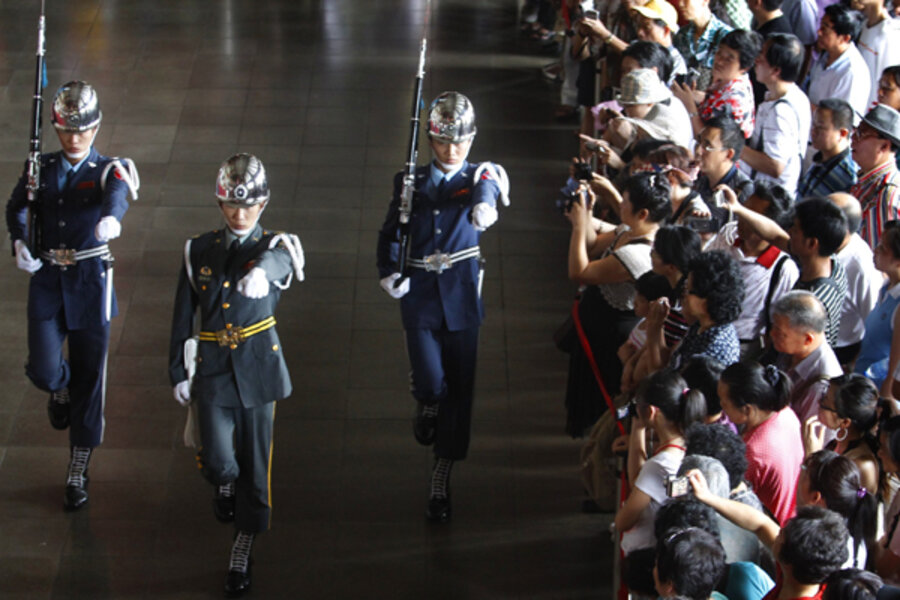Taiwan welcomes China’s tourism boom. But Chinese tourists, not so much
Loading...
| Taipei, Taiwan
The tour guide stood in Taiwan's National Palace Museum lobby, waving a tattered green pennant. She was trying to round up a group of Chinese tourists from Jiangsu Province in the first day of a weeklong tour of the island.
Things hadn’t gotten off to a great start. Several members of the tour group had failed to show up at the agreed time. “It’s the first day, and they’re already lost,” the tour guide grumbled, after hanging up her cell phone.
So go the awkward relations between the Taiwanese and their mainland cousins. They’ve been seeing a lot more of each other lately, as warming cross-strait ties have opened the island to thousands of Chinese tourist arrivals each day.
An agreement in summer 2008 lifted a cap on Chinese tourists and added more cross-strait flights to carry them. After a slow trial period, Chinese tourists arrivals are now up to some 3,400 per day. More than a million are expected to visit in 2010 – up from just 55,000 in 2005, according to Taiwan government statistics.
This week, news came that Taiwan may allow up to 500 individual tourists arrivals per day from select cities in China as early as next spring (now, Chinese can only come in groups on tightly controlled itineraries).
Learning tourist etiquette
The Taiwanese have decidedly mixed feelings about all this. Tour agencies, hotel operators, and airlines love the boost in revenues. But it’s rare to find a Taiwanese who’s enthusiastic about throwing open the doors to the Chinese.
Chalk it up to a culture clash: for many Taiwanese, especially refined residents of Taipei, Chinese tourists are the bumpkin cousins tracking mud into their expensive foyer. Taiwanese stereotype the Chinese as smoking, spitting, coughing, bellowing, and generally uncouth visitors.
Still, many Taiwanese are patient with the Chinese, remembering that Taiwan tourists behaved much the same way a few decades ago, when the island first got rich and they began vacationing abroad in large numbers. And tourists’ behavior is expected to improve as smaller, more diverse groups from across China take the place of one of today’s typical groups: male, chain-smoking local Communist Party officials on a junket to the “renegade province.”
Politics also loom over tourist visits. Last year, Taiwan media reported that China had told its tour groups to cancel trips to southern Taiwan, after local pro-independence officials in the south invited the Dalai Lama – reviled by China for his support of Tibetan autonomy – for a visit.
Museum rivalry
That was only a minor hiccup, though, as a visit to Taiwan's National Palace Museum shows. The museum is a mandatory stop for Chinese tour groups, as it contains imperial treasures taken (Chinese would say, “stolen”) from Beijing's Forbidden City when the Kuomintang fled from the Japanese and, later, the Chinese communists. The KMT later brought the treasures to Taiwan and stuck them in a hillside palace in the lush hills on the city’s north side.
Now, Chinese tourists make up more than half of the 5,000 to 7,000 foreign tourists that visit every day, say museum staff – or up to 10,000 on weekend days. They come to gaze at curios, calligraphy, rare books, landscape paintings, and jade carvings that were out of reach to Chinese for nearly six decades.
At the museum, the tour guide said that sometimes Chinese tourists jokingly ask her to “help us get our treasures back.” They may have a chance to at least borrow some of them soon: Taiwan’s palace museum has been cozying up to its counterpart in Beijing with exchanges and, last year, a joint exhibit. Still, China hasn’t yet been willing to give Taiwan a written guarantee it will get its art back if loaned.
The tour guide said groups first came over from China's Zhejiang Province, then Jiangsu, then the Dongbei (northeast) provinces, and most recently, Inner Mongolia. “They want to know, are there more treasures here, or in Beijing,” she says. The answer: Beijing's museum has a numerical edge in possessions, but Taiwan’s collection is viewed as far better.
Lingering nearby, the Jiangsu tourists waited for their wayward compatriots and chatted among themselves. A Taiwanese ticket-taker wearing a surgical mask stood nearby, next to a sign saying “Please keep your voice down.” She said, with a tone of relief, that there weren’t so many Chinese tourists at this time of day. “They’re so noisy,” she says, with a quick shake of her head and a giggle.
Related stories:





